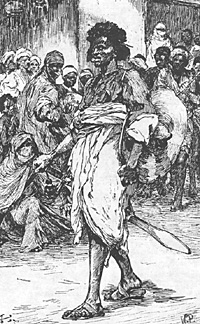 The British officers attached to the
Egyptian army were new to Egypt and the Sudan,
and their inexperience showed in their
assessments of their own soldiers and the
enemy. The Egyptian army contained a wild
variety of regular and irregular soldiers, from
the conscript Egyptian peasant, to the Albanian
and Circassian freebooter, to the enslaved
black African rifleman, to the loyal tribal levy.
The British officers attached to the
Egyptian army were new to Egypt and the Sudan,
and their inexperience showed in their
assessments of their own soldiers and the
enemy. The Egyptian army contained a wild
variety of regular and irregular soldiers, from
the conscript Egyptian peasant, to the Albanian
and Circassian freebooter, to the enslaved
black African rifleman, to the loyal tribal levy.
Mahdist Soldier
It is no wonder that the authorities in Cairo didn't really know what to make of it all, and it is no wonder that Baker, like Hicks, misjudged his own men. Before 1884 the British command in Egypt was guided by a misapprehension that the Egyptian army could best be built around the 'martial races" whose innate fighting qualities were their best guarantee in battle. After 1884 the British transferred all their faith to training.
In confronting the Beja's tactics (described in part 1), Baker decided to have his men form one large square, as he feared that a series of smaller battalion squares might fire on each other. In the end the two flanking battalion squares of Turkish infantry and the Massawa Sudanese were overwhelmed when the larger square broke. It must be remembered that many of the men in the army were scarcely trained: especially the Turks and bazinqirs.
The gendareerie, when attacked, fired wildly in the air or from the hip, taking little aim. The only veteran troops in the column were the Sannaheit and Massawa battalions of Sudanese, and of these the Massawa battalion was considered the best. As the attack developed they found themselves on the flank of the square where they could do the least good. After the battle Baker admitted that a different formation, and a reliance on his Sudanese regulars, might have brought about a different result (Wylde: 108).
The Egyptian army was well armed, with single-shot breech loading Remington rifles and carbines, two gatling guns (never used), two rocket tubes (likewise never used), and two Krupp field guns. In addition to this the various irregulars in the force had a variety of muzzle-loading muskets and rifles.
The main defence of Suakin rested with the Royal Navy, who had a number of small ships. The two east powerful were the corvettes Carysfort and Euryalus. Both were steam powered, masted cruisers, with broadside mountings rather than turrets. The Carysfort, at 2,380 tons and measuring 225' x 44' x 19', carried two 7" MLR and twelve 64pdrs. The Euryalus, at 3,932 tons and measuring 280' x 45' x 23.5' had fourteen 7" MLR (on slide mounts) and two 6" MLR (on trucks) (Archibald: 41, 49).
Wars in Eastern Sudan Part 2: Baker & El Teb
- Re-inforcements
Second Battle of El Teb
Troops and Tactics
Uniforms
Illustration: Egyptian Troops from Eastern Sudan (166K)
Wargame Ideas
Footnotes and Bibliography
Back to Table of Contents -- Savage and Soldier Vol. XIX No. 2
Back to Savage and Soldier List of Issues
Back to MagWeb Magazine List
© Copyright 1987 by Milton Soong.
This article appears in MagWeb.com (Magazine Web) on the Internet World Wide Web.
Other articles from military history and related magazines are available at http://www.magweb.com